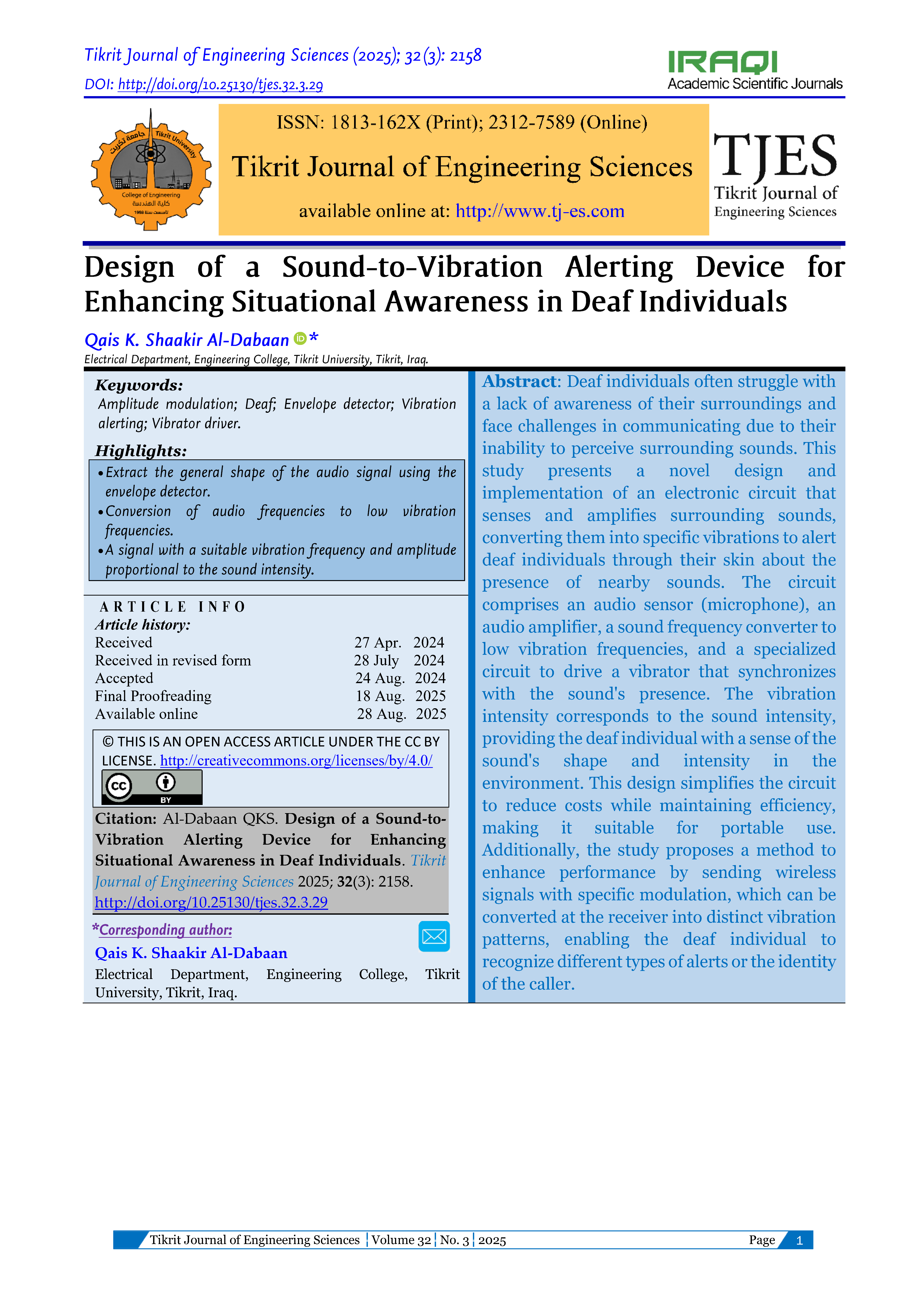Design of a Sound-to-Vibration Alerting Device for Enhancing Situational Awareness in Deaf Individuals
Main Article Content
Abstract
Deaf individuals often struggle with a lack of awareness of their surroundings and face challenges in communicating due to their inability to perceive surrounding sounds. This study presents a novel design and implementation of an electronic circuit that senses and amplifies surrounding sounds, converting them into specific vibrations to alert deaf individuals through their skin about the presence of nearby sounds. The circuit comprises an audio sensor (microphone), an audio amplifier, a sound frequency converter to low vibration frequencies, and a specialized circuit to drive a vibrator that synchronizes with the sound's presence. The vibration intensity corresponds to the sound intensity, providing the deaf individual with a sense of the sound's shape and intensity in the environment. This design simplifies the circuit to reduce costs while maintaining efficiency, making it suitable for portable use. Additionally, the study proposes a method to enhance performance by sending wireless signals with specific modulation, which can be converted at the receiver into distinct vibration patterns, enabling the deaf individual to recognize different types of alerts or the identity of the caller.
Metrics
Article Details

This work is licensed under a Creative Commons Attribution 4.0 International License.
THIS IS AN OPEN ACCESS ARTICLE UNDER THE CC BY LICENSE http://creativecommons.org/licenses/by/4.0/
Plaudit
References
Reza Hashemian. Cost-Effective Design of Amplifiers for Hearing Aides Using Nullors for Response Matching. International Conference on Electrical, Computer and Energy Technologies 2021 December 09-10; Cape Town, South Africa. IEEE. DOI: https://doi.org/10.5772/intechopen.97842
Ki Woong Seong, Ha Jun Mun, Dong Ho Shin, Jong Hoon Kim, Hideko Heidi Nakajima, Sunil Puria, Jin-Ho Cho. A Vibro-Acoustic Hybrid Implantable Microphone for Middle Ear Hearing Aids and Cochlear Implants. Sensors 2019; 19(5):1117. DOI: https://doi.org/10.3390/s19051117
Michael V Perrotta, Thorhildur Asgeirsdottir, David M Eagleman. Deciphering Sounds Through Patterns of Vibration on the Skin. Neuroscience 2021; 15(458):77-86. DOI: https://doi.org/10.1016/j.neuroscience.2021.01.008
Shachar Maidenbaum, Roni Arbel, Galit Buchs, Shani Shapira, Amir Amedi. Vision Through Other Senses: Practical Use of Sensory Substitution Devices as Assistive Technology for Visual Rehabilitation. 22nd Mediterranean Conference on Control and Automation 2014 June 16-19; Palermo, Italy. IEEE. DOI: https://doi.org/10.1109/MED.2014.6961368
Ryuichi Shimoyama. Omnidirectional Haptic Guidance for the Hearing Impaired to Track Sound Sources. Signals 2021; 2(3):490-507.
Yasothei Suppiah, M Chandran Maruthan, Fazly Salleh Abas. Hearing Aid Through Skin Sensory for Profound Deaf People. F1000Research 2021; 10(926). DOI: https://doi.org/10.12688/f1000research.72979.1
Mandlenkosi Shezi, Abejide Ade-Ibijola. Deaf Chat: A Speech-to-Text Communication Aid for Hearing Deficiency. Advances in Science, Technology and Engineering Systems 2020; 5(5):826-833. DOI: https://doi.org/10.25046/aj0505100
Bob Cordell. Designing Audio Power Amplifiers. 1st ed. McGraw-Hill/TAB Electronics; 2010.
Tietze U, Schenk C, Gamm E. Electronic Circuits Handbook for Design and Application. 12th ed. Springer; 2002.
Claudio Zippenfennig, Bert Wynands, Thomas L Milani. Vibration Perception Thresholds of Skin Mechanoreceptors Are Influenced by Different Contact Forces. Journal of Clinical Medicine 2021; 10(14):3083. DOI: https://doi.org/10.3390/jcm10143083
Martin Hartley Jones. A Practical Introduction to Electronic Circuits. 3rd ed. Cambridge University Press; 1995.
Granit Luzhnica, Sebastian Stein, Eduardo Veas, Viktoria Pammer, John Williamson, Roderick Murray Smith. Personalising Vibrotactile Displays Through Perceptual Sensitivity Adjustment. International Symposium on Wearable Computers 2017 September 11; New York. Association for Computing Machinery. DOI: https://doi.org/10.1145/3123021.3123029
Ciprian Seiculescu, Ioan Lie, Aurel Gontean. PWM Encoding Method for Wireless Communication in Sensor Networks. WSEAS Transactions on Circuits and Systems 2008; 4(7):194-202.
Ciprian Seiculescu, Ioan Lie, Aurel Gontean. Wireless Communication Techniques for Home Automation Sensors. *6th WSEAS International Conference on Computational Intelligence, Man-Machine Systems and Cybernetics* 2007 December 14:151-155.
Michael J Proulx, David J Brown, Achille Pasqualotto, Peter Meijer. Multisensory Perceptual Learning and Sensory Substitution. Neuroscience and Biobehavioral Reviews 2014; 41:16-25. DOI: https://doi.org/10.1016/j.neubiorev.2012.11.017
Chinh Nguyen. Haptic Obstacle Detector for the Blind. Master of Science Thesis. KTH Vetenskap och Konst; Stockholm, Sweden: 2014.
D. akopoulos, Sanjay Boddhu, N. Bourbakis. A 2D Vibration Array as an Assistive Device for Visually Impaired. Bioinformatics and Bioengineering Conference 2007 October 14-17; Boston, MA, USA. IEEE. DOI: https://doi.org/10.1109/BIBE.2007.4375670
Abhinav Vinod Deshpande. Deaf Alarm System. IJRIT International Journal of Research in Information Technology 2015; 4(2):1-7.
Maria Bianca Amadeo, Alessia Tonelli, Claudio Campus, Monica Gori. Reduced Flash Lag Illusion in Early Deaf Individuals. Brain Research 2022; 1776. DOI: https://doi.org/10.1016/j.brainres.2021.147744
Parivash Ranjbar, Dag Stranneby, Erik Borg. Vibrotactile Identification of Signal-Processed Sounds from Environmental Events. Journal of Rehabilitation Research and Development 2009; 46(8):1021-1036. DOI: https://doi.org/10.1682/JRRD.2008.11.0150
Anju L, Aniruddh Aiyengar, Tamil Selvan H, Vishnuvaradhan Moganarengam. Wearable Vibration-Based Device for Hearing-Impaired People Using Acoustic Scene Classification. International Research Journal of Engineering and Technology 2023; 10(1):100-119.
Danielle Bragg, Nicholas Huynh, Richard E Ladner. A Personalizable Mobile Sound Detector App Design for Deaf and Hard-of-Hearing Users. 18th International ACM SIGACCESS Conference 2016 October 23; New York, NY, United States. Association for Computing Machinery. DOI: https://doi.org/10.1145/2982142.2982171
Ryuichi Shimoyama. Omnidirectional Haptic Guidance for the Hearing Impaired to Track Sound Sources. Signals 2021; 2(3):490-507. DOI: https://doi.org/10.3390/signals2030030
Mete Yaganoglu Cemal Köse. Wearable Vibration Based Computer Interaction and Communication System for Deaf. Applied Sciences 2017; 7(12):1296. DOI: https://doi.org/10.3390/app7121296
Maythem K Abbas, Bie Tong, Raid Abdulla. A Hybrid Alert System for Deaf People Using Context-Aware Computing and Image Processing. 4th International Conference on Computer and Information Sciences 2018 August 13-14; Kuala Lumpur, Malaysia. IEEE. DOI: https://doi.org/10.1109/ICCOINS.2018.8510584





